How climate change could disrupt the construction and operations of US nuclear submarines
By Allie Maloney | April 14, 2025
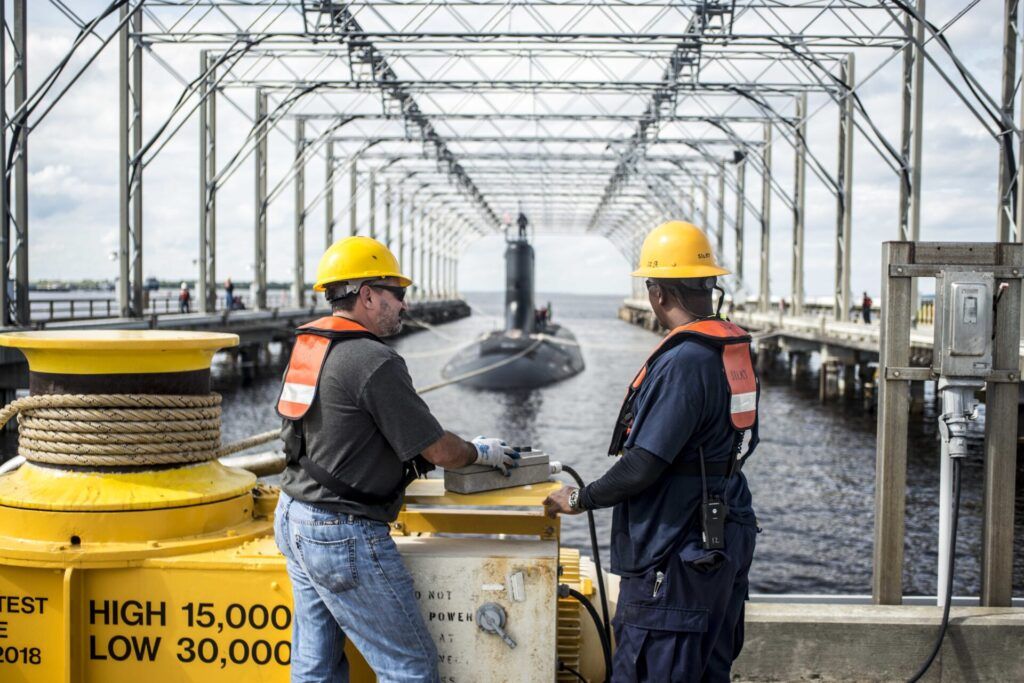 In the next 50 to 100 years, sea levels will rise to flood the areas surrounding the Strategic Weapons Facility Atlantic and the Explosive Handling Wharves at Kings Bay Naval Base—two facilities responsible for the storage and assembly of the Trident II D5 sea-launched ballistic missile for US nuclear-armed submarines. (Credit: US Navy /Bradley Gee)
In the next 50 to 100 years, sea levels will rise to flood the areas surrounding the Strategic Weapons Facility Atlantic and the Explosive Handling Wharves at Kings Bay Naval Base—two facilities responsible for the storage and assembly of the Trident II D5 sea-launched ballistic missile for US nuclear-armed submarines. (Credit: US Navy /Bradley Gee)
The US Defense Department is currently in the midst of a multi-decade-long nuclear modernization effort that includes replacing all the nuclear submarines making up the sea leg of the US nuclear triad. The nuclear-armed and -powered submarines—which hold over half of deployed US nuclear warheads—are known for their “survivability,” thereby providing the United States with second-strike capability even after a surprise attack.
But climate change could make the US submarine force inoperable over the coming decades.
Rising sea levels and extreme weather events increasingly threaten the submarine force’s infrastructure, which is mainly located in at-risk flood areas. This vulnerability reveals the precarious state of nuclear weapons—which the Defense Department considers the “backbone of America’s national security”—to the threat of climate change.
Threat multiplier. The Navy plans to spend $130 billion on procuring new Columbia-class nuclear-powered ballistic missile submarines (SSBNs) over the next two decades to replace the current Ohio-class fleet. The delivery of the lead boat—the USS District of Columbia (SSBN-826)—has already been delayed by 12 to 16 months due to insufficient work instructions, low material availability, and disruptions from the COVID-19 pandemic. It is now only about halfway through construction. According to the Government Accountability Office, budget overruns are five to six times higher than estimates by the Navy and General Dynamics Electric Boat, the submarine’s building company. As the Pentagon spends more and more on modernizing its nuclear submarines, natural disasters are likely to disrupt supply chains and damage nuclear facilities, sinking costs further.
In recent years, the Defense Department has started to acknowledge climate change as a “threat multiplier”—albeit slowly. Acknowledging the billions of dollars climate change could cost the Navy in the future, the Pentagon now incorporates inclement weather disasters and other climate effects into military planning and base structures. However, during the first Trump administration, the Navy quietly ended the climate change task force put in place by the Obama administration, which taught naval leaders how to adapt to rising sea levels. As the new Trump administration wipes all mention of climate change and other environmental measures from federal agency websites, climate-related measures may also be halted despite being critical for the viability of naval missions.
Most of the naval construction and operations infrastructure for the United States’ ballistic missile submarines are located on the Pacific and Atlantic coasts. Due to sea level rise and increased inclement weather attributed to climate change, these facilities are becoming more vulnerable to flooding. The intensity and number of hurricanes in the North Atlantic region have increased since the 1980s and will continue to do so as ocean temperatures keep rising, further threatening coastal areas. These incidents are highly costly and disruptive to operations. According to a Congressional Research Service report, the Defense Department has 1,700 coastal military installations that could be impacted by sea level rise. In 2018, Tyndall Air Force Base in Florida suffered $4.7 billion in damages from Hurricane Michael.
Infrastructure at risk. General Dynamics Electric Boat—the lead contractor for the new Columbia-class submarines—performs over three-quarters of the construction operations for the 12 new ships at its two shipbuilding facilities located in Rhode Island and Connecticut. Both facilities are in at-risk flood areas.
General Dynamics’ shipyard at Quonset Point, Rhode Island, is shown on NOAA’s Coastal Flood Exposure Map—a tool that visualizes geographic areas vulnerable to flooding—as having a mix of flood zones (see Figure 1). The shipyard’s steel and manufacturing shops are in an area of moderate risk to storm surges from category 2 and 3 hurricanes, with a 0.2-percent annual chance of flooding. Despite being considered “non-special flood hazard areas,” these zones receive one-third of the Federal Emergency Management Agency’s assistance for flooding.
Other facilities—such as those responsible for assembling cylinders that make up the body of submarines, processing steel, and loading the cylinders for transportation—are in “special flood hazard areas” or high-risk zones, with a general one-in-four chance of flooding every 30 years. They are also at risk of storm surge from hurricanes of categories 3 and lower. This means this area of the shipyard is projected to be flooded at least once in a hundred years. Flooding at these facilities would, at a minimum, further delay the construction and delivery of ships.
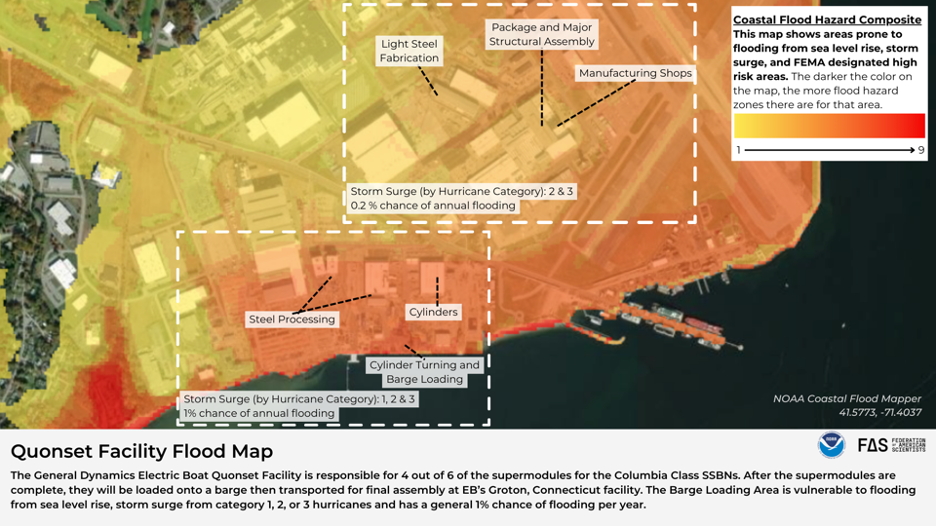
The ships are built separately in large sections, or “super modules,” and then assembled. Once the majority of these super modules are completed at Quonset, they are loaded onto a barge and taken to another General Dynamics facility in Groton, Connecticut, for assembly. The company invested almost $2 billion in the construction of new facilities to complete the Columbia class. At Groton, an entirely new assembly building has been constructed in an area at risk of coastal flooding from storm surges and sea level rise (see Figure 2).
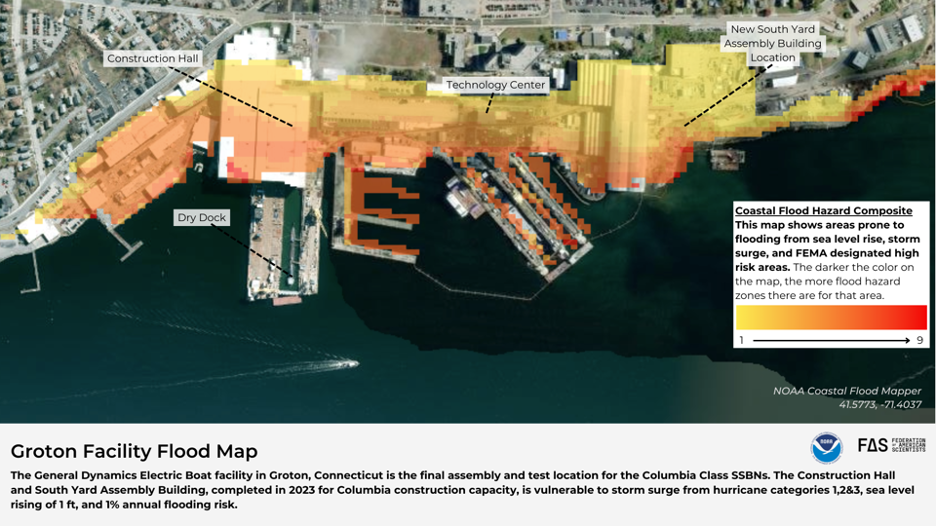
Mission disruptions. Not only is the construction of the Columbia class submarines at risk from environmental hazards, but the deployment of the boats may also face challenges. Carnegie expert on climate and nuclear security Jamie Kwong observed that sea level rises put Kings Bay Naval Base in Georgia—one of the two SSBN home ports—at risk of flooding, too.
In the next 50 to 100 years, sea levels will rise to flood the areas surrounding the Strategic Weapons Facility Atlantic and the Explosive Handling Wharves at Kings Bay—two facilities responsible for the storage and assembly of the Trident II D5 sea-launched ballistic missile for US nuclear-armed submarines. Flooded roads will make it difficult to transport the missiles to the dry dock from which they are loaded into submarines to carry out their mission.
Extreme weather events may soon cause storm surges that flood the area. In Camden County, where Kings Bay Naval Base is located, NOAA documented an increase in significant weather events over time, with seven events in 1980-1990, 65 in 1990-2000, 126 in 2000-2010, and 104 in 2010-2020.
In the fall of 2024, hurricanes Helene and Milton threatened Kings Bay, forcing the base to be closed except for mission-essential personnel. For five days during Hurricane Helene, employees of the Trident Training Facility were ordered not to come to work, with the official Kings Bay Facebook page posting regular updates about the status of the storm. During one of these updates, the Sub Base Commanding Officer placed the base under Tropical Cyclone Condition of Readiness 2 (TCCOR2) with destructive force winds possible. A video later showed downed trees at the base (Figure 3).
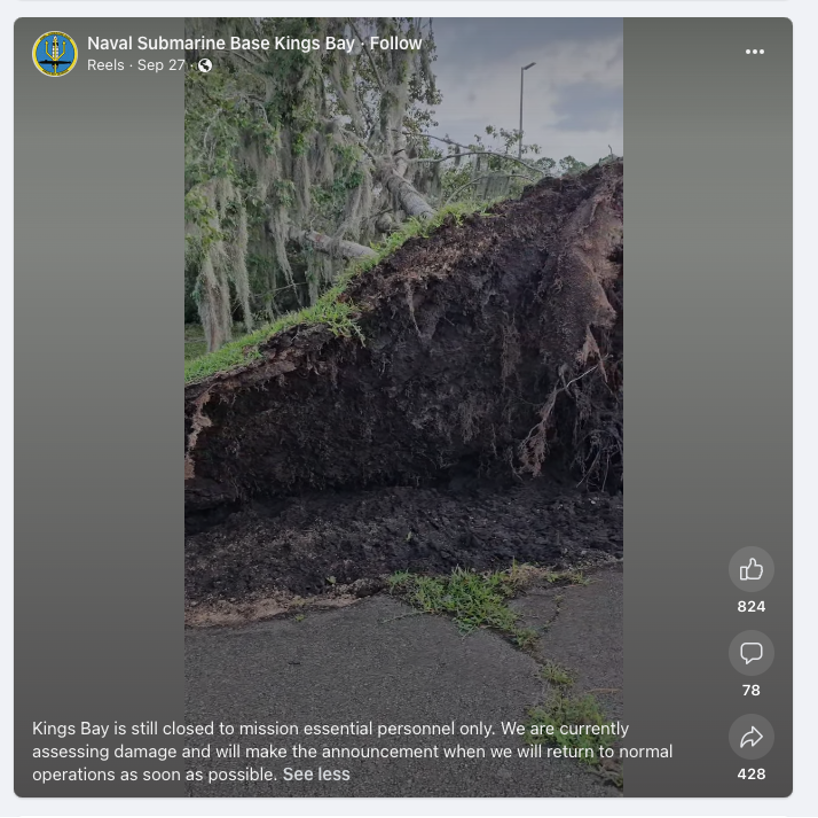
A week later, in early October, Kings Bay base was again limited to essential personnel only for three days as Hurricane Milton ravaged the south. Satellite imagery did not indicate substantial flooding from the hurricanes at the base itself, but Kings Bay may not have the same luck during future hurricane seasons.
Self-induced vulnerability. The Navy’s Final Environmental Assessment for the Columbia class submarines estimated that homeporting at Kings Bay, Georgia, would result in emissions of 998 metric tons of carbon dioxide equivalent. This is equivalent to 1,108,593 pounds of coal burned and the amount of carbon sequestered by 1,001 acres of US forests in one year. General Dynamic’s greenhouse gas emissions for 2023 were around 713,874 metric tons—over 700 times higher. While it had committed to reducing GHG emissions in 2019, the company’s emissions have increased since taking on several Pentagon contracts related to nuclear modernization.
The geophysical threats the nuclear deterrent faces show just how precarious these weapons are. As the United States builds new ships for national security, it also contributes to the sinking of its bases. A nuclear weapon buildup is vulnerable to changing environments and cannot save the United States from the looming threat of climate change.
Together, we make the world safer.
The Bulletin elevates expert voices above the noise. But as an independent nonprofit organization, our operations depend on the support of readers like you. Help us continue to deliver quality journalism that holds leaders accountable. Your support of our work at any level is important. In return, we promise our coverage will be understandable, influential, vigilant, solution-oriented, and fair-minded. Together we can make a difference.


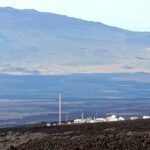





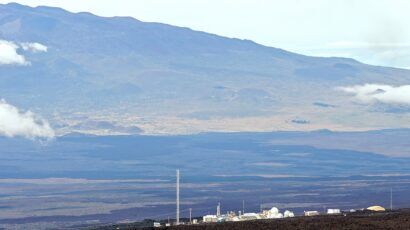
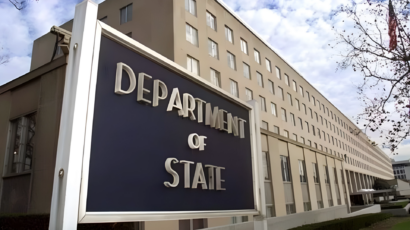
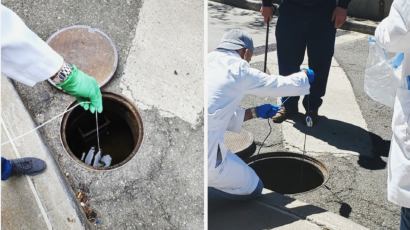


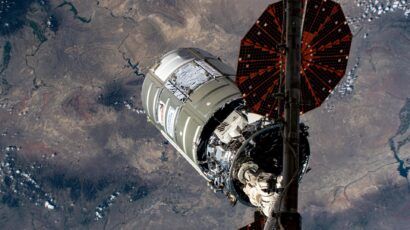


Uninformed people wonder why the Bulletin coverage and the changes of the Doomsday Clock, have been including climate change in the calculations. Well folks, here’s a perfect article to educate you on how something like a a monster sized calving ice segment from Antarctica and other global weather changes can affect our decisions and safety in the development or use of our nuclear triad. Relocating bases, ports suitable for repairs and upkeep of our big missile boats would be very expensive and difficult to plan ahead for. Our daily lives are slowly but constantly being affected by what our changing… Read more »